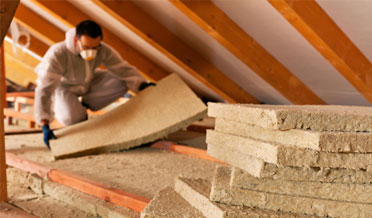Insulation Installation 101
Heating and Insulation Installation 101
Early Structures
Most homes built in the early days of North American settlement were simple log structures, made of the thickest logs one could find or afford. Doors and windows were rudimentary and ill-fitting. Logs would expand and contract according to the temperature, so the material between the logs, chinking, moved, and needed to be repaired constantly.
The insulation value of the building material was essentially the thickness of the log and the attention paid to repairing the chinking. A blazing fire was the best shield against the bitter cold.
When sufficient power was available, the logs were milled into boards and stick framing became popular. Doors and windows improved but were still letting in a lot of breezes. Wood frame houses made housing more affordable, not necessarily more comfortable.
The gap between the outer shell and the finished inside walls was still empty; the air is a poor insulator and vapor barrier. Upper stories in most buildings were uncomfortably hot in the summer months and lower stories could only be warmed during the winter with multiple fireplaces.
Energy Attention
As the population increased and technology developed, buildings—especially residences—were designed with features that kept conditioned air inside longer.
Homes with multiple fireplaces, burning lots of wood each winter, were no longer practical. The price of fuel oil, coal, and natural gas drove the development of insulation.
Insulation is the term for a barrier to the transfer of energy. Sometimes the barrier is solid and sometimes the barrier is a material that traps air and uses the trapped air to resist the transfer of energy in the form of heat. A common term used in rating insulation value is R-Value; the “R” stands for resistance.
The higher the number, the better the product is in resisting the transfer of heat energy. Every material used in the construction of your home has an R-Value, but it is most commonly observed on wall and attic insulation.
Common Insulators
Below are the three most common insulation materials used in new residential construction, listed in ascending R-Value ratings:
- The most common residential insulator in both walls and attic is glass, blown into long fiber strains, commonly referred to as fiberglass. Fiberglass entangle and form pockets of trapped air. It can be blown under pressure or manufactured into strips, called batts.(Rock wool is a similar technology, but the inhalation of the material has been demonstrated to be harmful. Use extreme precautions and use personal protective equipment when handling.)
- This product is made from recycled paper that has been treated to be insect, rodent, and fire-resistant. It is typically blown into walls and attics slightly moist; the moisture activates an adhesive that binds the piece.Very little air is trapped between fibers: instead, the insulation factor is determined by the density of the product. The dense material prevents both drafts and the transfer of energy.
- Dense foam is used in various applications as wall and ceiling insulation. Applications include solid sheet, solid block concrete forms, and liquid expanding foam installations. The R-Value depends upon the density of the material. Foam insulation is generally very resistant to air movement.
What Can I Do?
There are four surfaces that you can commonly address and the most convenient time to address them. Installing more insulation or better insulation at opportune times will save on your energy bill.
- Attic insulation installation. Approximately 80% of energy lost in the typical home is lost through the attic. Building regulations require more insulation in the attic than any other portion of the home. Most homes will have access to the attic space through stairs, a ladder, or an opening in the ceiling. Take a flashlight and have a look around.Depending upon the type of insulation, you should see 10” to 12” of insulation over ALL the attic. You should see a complete blanket, with no exposed ceiling joists. If you need more insulation, it can be installed at your convenience. However, the worst times to be in the attic are during times of extreme temperature—extreme heat or extreme cold.
- Wall insulation installation. Addressing walls becomes problematic since walls are generally covered with a hard, permanent material. The time to insulate/better insulate walls is when they are exposed for any reason. That includes remodeling, restoration, or room additions. Also, consider insulation on foundation walls and unfinished basements.
- Windows and Doors insulation installation. Glass is a poor insulator, but windows are needed and desirable. The key to improving insulation around windows and doors is preventing air penetration through gaps around the edges.The proper materials to clog these opens include:
- Glazing around older windows
- Caulk or foam applied at the trim and edges around the opening
- Weatherstripping
Wondering if heating or cooling your home is energy efficient? Call Air Pro Houston for your energy audit today and to schedule Insulation Installation!
Questions About Insulation Installation?
Our four decades of experience as an HVAC System maintenance contractor, AirPro Houston provides you with the skill and expertise to assist in Insulation Installation.
We have several financing options available with great options with up to 72-month terms with approved credit. Call us today at 281-880-8805 and let us partner with you for all of your HVAC repair and installation needs.

